This guide initially displays all common mammals. Use the selectors below to view mammals of a particular shape, include rare mammals, or search for them by name.
Mammals are defined as warm-blooded vertebrates with hair or fur and sweat glands — in the females mammary glands, modified sweat glands, produce milk to nourish the young. Most mammals develop a placenta which enables the feeding of the fetus during gestation and give birth to live young. In addition, although most mammals walk on land, many have specific adaptations that allow them to swim, fly, leap between tree branches or even dig extensive tunnels. Many wild mammals are used for both food and fur. while other have been domesticated for their agricultural and scientific importance.
New Mexico ranks high for mammalian diversity in the states in the US and the Pajarito Plateau is home to many of these species. This guide describes all of the larger wildlife found in the area as well as the more common smaller animals with the most abundant being rodents. Local species range from carnivores like the mountain lion and bobcat to ruminants like elk and deer to to several varieties of bats.
Mammal References
Biota Information System of New Mexico
Bogen et al. 1998 Continued Studies of Bat Species of Concern in the Jemez Mountains, New Mexico [PDF]
eNature
Frey et al. 2006 Checklist of New Mexico Mammals [PDF]
New Mexico Tech Mammalian Field Guide
Smithsonian National Museum of Natural History North American Mammals
Threatened, Endangered and Sensitive Species Profile – Los Alamos Laboratory Lands [PDF]
Tyrell and Brack 1992 Survey for Bats in the Los Alamos National Environmental Research Park
Subject Area Experts (all guides)
Steve Cary (butterflies)
Beth Cortright (insects)
Terry Foxx (invasive plants)
Leslie Hansen (mammals)
Richard Hansen (fish, mammals)
Dorothy Hoard (butterflies, trees)
Chick Keller (flowers, herbarium)
Shari Kelley (geology)
Kirt Kempter (geology)
Garth Tietjen (reptiles)
David Yeamans (birds)
Web Development and Content Management
Pat Bacha
Jennifer Macke
Graham Mark
Akkana Peck
Contact
Please contact us for local nature questions and sightings. We welcome comments, corrections, and additions to our guides.
For more information about local nature, please visit our Nature Blog or subscribe to PEEC This Week.
Make Selection
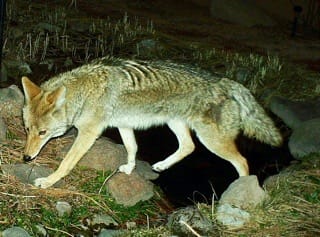 Photo: Hari Viswanathan - Crittercam |  Coyote(Canis latrans)Family: Canidae (Canines) Size: 42 - 54 in (107 - 137 cm) Status: native; common Habitat: open plains, towns, scrubby areas, fields Coyotes are seen most commonly at dusk or dawn. Coyotes are primarily carnivores, preying on a variety of animals as large as deer and as small as some rodents. They can live together in a family unit, a pack of unrelated individuals, or alone. Coyotes are known for their characteristic howl that has given the species its scientific name, Canis latrans, meaning barking dog. The Coyote is often depicted as a trickster in Southwestern Native American folklore where it uses deception and humor to oppose social conventions. Tracks Info Photos Distribution Featured |
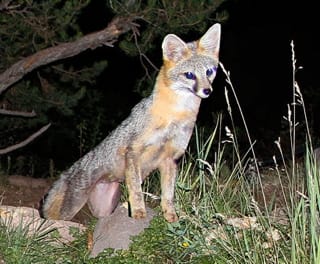 Photo: Hari Viswanathan - Crittercam |  Gray Fox(Urocyon cinereoargenteus)Family: Canidae (Canines) Size: 30 - 44 in (76 - 112 cm) Status: native; uncommon Habitat: wooded and bushy areas, grassy areas and prairies, open fields Typical location: Barranca Mesa The Gray Fox is active at night and during twilight. It is a solitary hunter, preying mostly on rodents and rabbits though it will eat insects and some plant material. It is the only American canid that can climb trees using its strong, hooked claws to scramble up to reach food and to escape predators. Once in a tree, it can jump from branch to branch. The Gray Fox makes its den in a hollow tree or abandoned burrow where it rests during the day. Tracks Info Photos Distribution Featured |
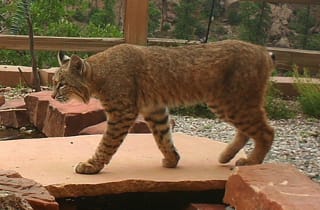 Photo: PEEC - Crittercam |  Bobcat(Lynx rufus, Felis rufus)Family: Felidae (Cats) Size: 28 - 49 in (71 - 124 cm) Status: native; common Habitat: scrubland by country, mixed forests, rocky or bushy arid lands Bobcats are crepuscular, hunting from dusk to midnight and then again from dawn to sunrise. They are solitary and territorial, marking boundaries with claw marks and deposits of urine and feces. Bobcats roam large areas with ranges reported over 100 sq mi (250 sq km). They take prey anywhere in size from a mouse to a rabbit. Tracks Info Photos Distribution Featured |
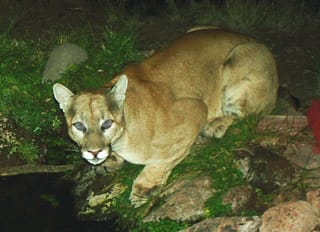 Photo: Hari Viswanathan - Crittercam |  Mountain Lion, Cougar(Puma concolor)Family: Felidae (Cats) Size: 72 - 108 in (183 - 274 cm) Status: native; uncommon Habitat: mountainous, semi-arid terrain, brushlands, forests Mountain Lions are slender and agile with large paws and hind legs. They are adept at climbing. They are secretive and solitary by nature and are mostly nocturnal. Mountain Lions are ambush predators primarily eating ungulates such as deer and livestock. They prefer to live in places conducive to stalking — areas with dense underbrush and rocky outcrops. Once prey is sighted, they will leap onto its back and deliver a killing bite. Tracks Info Photos Distribution Featured |
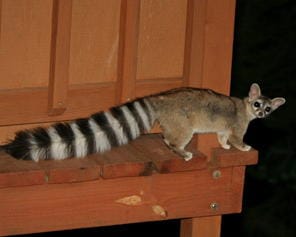 Photo: Hari Viswanathan |  Ring-tailed Cat, Ringtail, Miner's Cat, Marv Cat(Bassariscus astutus)Family: Procyonidae (Raccoons, Ringtails, and Coatis) Size: 24 - 32 in (61 - 81 cm) Status: native; uncommon Habitat: rocky areas, wooded areas with hollow trees Typical location: Los Alamos A rarely-seen nighttime visitor. This one was photographed while raiding a hummingbird feeder on North Mesa. This small procyonid is solitary and rather shy. It is an omnivore, consuming fruits, insects and a large variety of small birds, rodents and reptiles. It produces numerous clicking and chattering sounds as well as a loud bark. Info Photos Distribution |
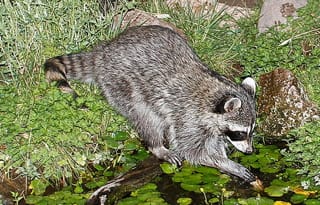 Photo: Hari Viswanathan - Crittercam |  Northern Raccoon(Procyon lotor)Family: Procyonidae (Raccoons, Ringtails, and Coatis) Size: 24 - 37 in (61 - 94 cm) Status: native; uncommon Habitat: woods and forests, wetlands, meadows, suburbs and rural areas Typical location: White Rock The Northern Raccoon is highly intelligent and very adaptable as to where it can live. It will eat almost anything it finds. These animals are primarily active from sunset to sunrise. Their most import sense is that of touch. They have hypersensitive front paws that become pliable when wet. They often move along a shoreline picking up a food item from under the water and rubbing it with their paws, appearing as if they are washing the food. Their most distinctive feature is their dark facial mask surrounded by white. The mask is thought to give them better night vision. Tracks Info Photos Distribution |
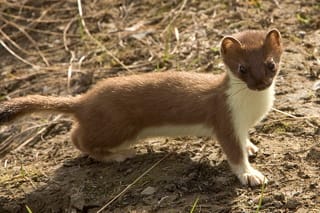 Photo: Steve Hillebrand, US Fish & Wildlife Service 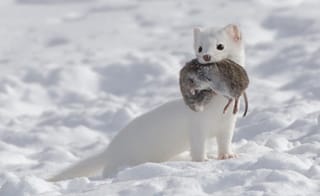 Photo: redfaux |  Short-tailed Weasel, Ermine, Stoat(Mustela erminea)Family: Mustelidae (Weasels, Badgers, and Otters) Size: 7.5 - 13.5 in (19 - 34 cm) Status: native; uncommon Habitat: open woodlands, brushy areas, grasslands, farmland, towns The Short-tailed Weasel is native throughout North America and Eurasia where it is more commonly known as a Stoat. It has short, rough fur that is brown in summer (top photo) and silky, fine fur that is white in winter (bottom photo). The name Ermine is most often used to refer to the animal in its winter coat. Its tail length is about a third of its total body length and is tipped in black even in winter. The winter coat has been prized for centuries for its use a luxury fur. Short-tailed Weasels are fierce hunters, primarily catching small rodents. They will often use the burrows of the rodents they kill as their own. They will also often live in old stumps, under tree roots or vacant buildings. Tracks Info Photos Distribution |
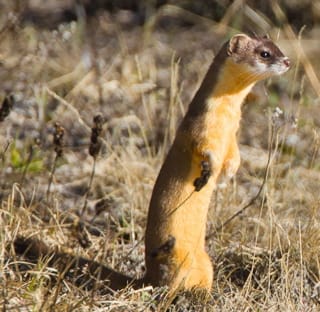 Photo: Greg Lasley |  Long-tailed Weasel(Mustela frenata)Family: Mustelidae (Weasels, Badgers, and Otters) Size: 11 - 22 in (28 - 56 cm) Status: native; uncommon Habitat: forest, brushy and open areas, farmland, woodland, near water The Long-tailed Weasels are relentless and voracious predators. They follow a solitary, secretive life but can be seen both day and night hunting for vertebrates like mice or rabbits. They, in turn, are hunted by birds of prey. The Long-tailed Weasel has a long bushy tail with a black tip that is about half of its total body length. They can produce a strong, foul-smelling scent which they use to mark territory, attract mates and discourage predators. There are numerous subspecies of Mustela frenata. As depicted in the photo, many in the Southwest have dark facial masks and varying white patches on their heads. Tracks Info Photos Distribution |
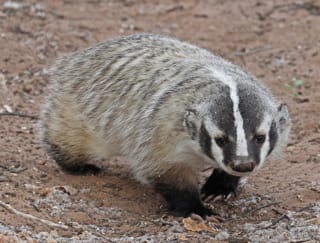 Photo: Jerry Oldenettel |  American Badger(Taxidea taxus)Family: Mustelidae (Weasels, Badgers, and Otters) Size: 20 - 34 in (51 - 86 cm) Status: native; uncommon Habitat: open plains, farmland, brushlands The American Badger is a rarely-seen mammal that is primarily nocturnal. It lives underground in a burrow that may be very extensive. It catches much of its food by using its strong legs to dig up small ground-dwelling rodents. However, it will also eat amphibians, insects, birds and worms. It is short and shaggy with a jaw that is formed in such a way that it cannot be dislocated allowing it to maintain a hold on struggling prey. Tracks Info Photos Distribution |
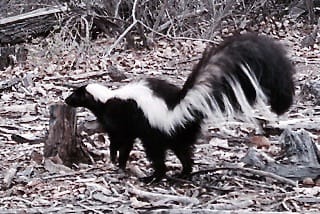 Photo: J. N. Stuart  Photo: Hari Viswanathan |  Striped Skunk(Mephitis mephitis)Family: Mephitidae (Skunks) Size: 20 - 31 in (51 - 79 cm) Status: native; common Habitat: desert, woodlands, grassy plains, cities and town, forests, brushlands Typical location: Los Alamos The Striped Skunk is nocturnal and eats various plant materials as well as insects, worms, rodents, amphibians and reptiles, eggs and even garbage. Like all skunks, it has the ability to spray a foul-smelling fluid from two glands near the base of its tail. It typically raises its tail and stomps its front feet before spraying. It uses this ability cautiously as it only carries enough fluid for a few uses and then must wait a week or so for the supply to be replenished. The Striped Skunk has few natural predators except birds of prey. It is currently the chief carrier of rabies in the US. Tracks Info Photos Distribution Featured |
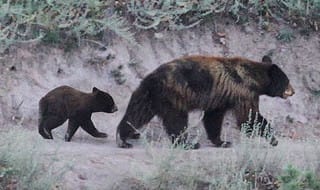 Photo: Hari Viswanathan 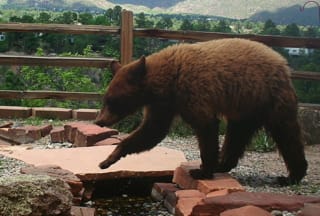 Photo: PEEC - Crittercam |  American Black Bear(Ursus americanus)Family: Uridsae (Bears) Size: 54 - 74 in (137 - 188 cm) Status: native; common Habitat: forests and wooded mountains, fruit trees Typical location: Barranca Mesa, White Rock Canyon The American Black Bear can be active at any time of the day or night but generally forages at night. Its diet varies depending on the season and location but relies heavily on fruit, nuts and vegation with a little meat and some insects. American Black Bears can climb trees but tend to lose this ability with age. They often make claw marks on trees as a forms of communication with other bears. In addition, they make a variety of sounds including growls, snorts and bellows as a sign of aggression. Most American Black Bears hibernate and do not eat, drink, urinate, or exercise for up to seven months of the year. Cubs are born while the mother is hibernating. Despite the common name, not all American Black Bears are black. Some are brown or cinnamon (lower photo). Tracks Info Photos Distribution Featured |
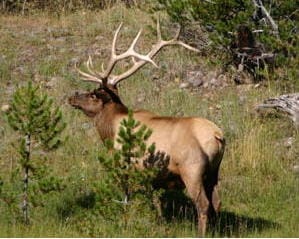 Photo: male by Hari Viswanathan 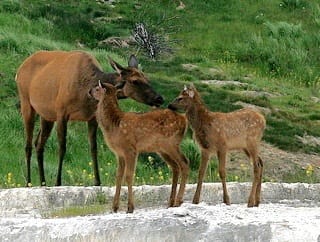 Photo: female and young by Brocken Inaglory |  American Elk, Wapiti(Cervus elaphus, Cervus canadensis)Family: Cervidae (Ruminants) Size: 78 - 117 in (198 - 297 cm) Status: native; common Habitat: high, open mountain pastures in summer, lower wooded slopes in winter Typical location: Jemez Mountains, Pajarito Canyon, Valle Caldera, White Rock The American Elk usually congregates in separate herds based upon sex except during the breeding season. Only the males (upper photo) have antlers. The antlers grow in the spring and are covered with “velvet” which is shed when they are fully developed. The males use a variety of ostentatious behaviors such as posturing, sparring and bugling to attract females (lower photo) in late September and October. After the mating season, the males shed their antlers. American Elk are hunted for their meat which is leaner and higher in protein than beef. Tracks Info Photos Distribution Featured |
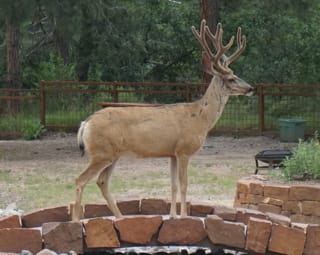 Photo: male by PEEC 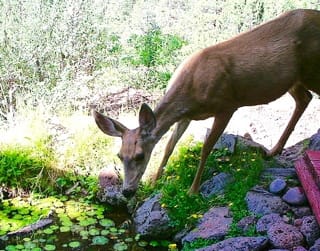 Photo: female by Hari Viswanathan - Crittercam |  Mule Deer(Odocoileus hemionus)Family: Cervidae (Ruminants) Size: 47 - 79 in (119 - 201 cm) Status: native; common Habitat: edges of mixed forests, mountains, foothills, towns Typical location: Los Alamos The Mule Deer, the common deer in the area, received its name from its large ears that resemble those of a mule. Larger ears, a black-tipped tail and the forked antlers distinguish them from White-tailed Deer. Small groups of deer often migrate to higher elevations during the warmer months looking for new-grown grasses, twigs, and shrubs; they then return to lower elevations during winter where they come together in larger groups in open meadows. Their diet varies greatly depending on the season and region. Males (upper photo) compete for the opportunity to mate in early fall. Soon after mating, their antlers fall off and begin to grow again soon thereafter. The females (lower photo) do not have antlers and are smaller than the males. Newborns are spotted for camouflage. Tracks Info Photos Distribution Featured |
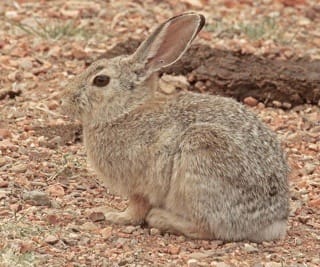 Photo: Jerry Oldenettel |  Desert Cottontail(Sylvilagus audubonii)Family: Leporidae (Hares and Rabbits) Size: 14.5 - 19.5 in (37 - 50 cm) Status: native; common Habitat: brush areas, desert, towns The Desert Cottontail is most active during the day but can be seen at dawn and dusk. It will hide in an abandoned rodent burrow or a shallow depression in the ground. Desert Cottontails mainly feed on grasses but eat leaves from shrubs as well as cacti and acorns. They get their water primarily from the food they eat or from dew. Like all rabbits and hares, they are coprophagic, i.e., eating their own feces to allow for more nutrition to be extracted from their food. They are prey animals for raptors, carnivorous mammals, snakes and even humans. This has led them to be cautious; they either freeze when alarmed or run away when startled at high speeds in a zigzag pattern. They can breed year-round depending on the food supply and the young mature quickly. Tracks Info Photos Distribution Featured |
 Photo: Josip Loncaric |  Mountain Cottontail, Nuttall's Cottontail(Sylvilagus nuttallii)Family: Leporidae (Hares and Rabbits) Size: 13.8 - 15.4 in (35 - 39 cm) Status: native; common Habitat: montane coniferous forests, open areas with lots of herbaceous vegetation The Mountain Cottontail is primarily active at dawn and dusk but always stays close to cover. It spends much of its time feeding on vegetation like sagebrush, juniper and grasses. It will even eat twigs and bark during winter. The cottontail’s feet are covered with long hair to protect it from the cold and the inside of its ears are furry. The Mountain Cottontail is similar to the Desert Cottontail but it is smaller and has shorter ears. Mountain Cottontails make cavity nests lined with fur. They can produce several litters each year. The young rabbits, as opposed to hares, are born blind and hairless. Tracks Info Photos Distribution Featured |
 Photo: J. N. Stuart |  Golden-mantled Ground Squirrel(Callospermophilus lateralis, Spermophilus lateralis)Family: Sciuridae (Squirrels, Chipmunks, Marmots, and Prairie Dogs) Size: 9.5 - 12.1 in (24 - 31 cm) Status: native; locally common Habitat: moist coniferous or mixed forest, open woodlands, brushy forest-edge habitats, dry margins of mountain meadows, and rocky slopes Typical location: Jemez Mountains The Golden-mantled Ground Squirrel is similar to a chipmunk with the same overall appearance. However, the ground squirrel lacks the chipmunk’s facial stripes. Golden-mantled Ground Squirrels eat almost anything including seeds, nuts, berries, insects, eggs and fungi. They are often seen in sunny disturbed areas searching for food. In general they are solitary animals and live in long shallow burrows that they dig themselves. They hibernate during winter. In summer they cache food in their nests for when they awake in spring. They are capable of carrying food in their cheek pouches while still running at full speed. Tracks Info Photos Distribution |
 Photo: Andrew Hollander 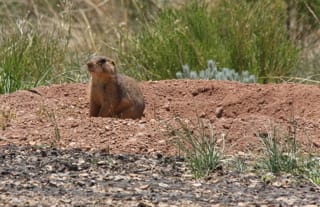 Photo: J. N. Stuart |  Gunnison's Prairie Dog(Cynomys gunnisoni)Family: Sciuridae (Squirrels, Chipmunks, Marmots, and Prairie Dogs) Size: 12.1 - 14.8 in (31 - 37 cm) Status: native; uncommon; sensitive species Habitat: shortgrass prairies in high mountain valleys at 6,000-12,000 ft (1,800-3,600 m) Typical location: Jemez Mountains, Valle Caldera The Gunnison's Prairie Dog is one of five prairie dog species in the US and the one that is found locally. They live in colonies of up to several hundred individuals made up of numerous smaller family groups. Each family group has its own set of burrows with separate areas for a nursery and sleeping quarters. They hibernate in their burrows during winter. During the warmer months they are most active in the early morning and late afternoon where their main activity involves finding food. They feed on grasses, herbs, and leaves, seeds, stems, roots and even insects depending on the season. Prairie Dogs have a very complex system of communication consisting of forms of physical contact and vocalization such as warning barks. The Gunnison’s Prairie Dog was considered for listing as a threatened species but the proposal was rejected in 2013. Info Photos Distribution Featured |
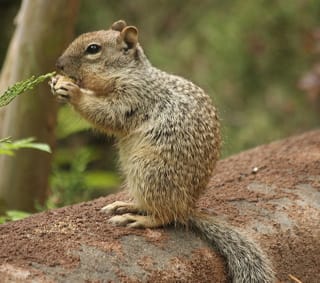 Photo: J. N. Stuart |  Rock Squirrel, Ground Squirrel(Otospermophilus variegatus, Spermophilus variegatus)Family: Sciuridae (Squirrels, Chipmunks, Marmots, and Prairie Dogs) Size: 17 - 21 in (43 - 53 cm) Status: native; common Habitat: rocky locales including boulder piles, hills, oak-juniper growth, towns Rock Squirrels have long bushy tails and look like tree squirrels. However, although they can climb trees they usually do not. They typically nest in a complex burrow near a good lookout spot. They are social and live in small colonies. The Rock Squirrel is predominantly an herbivore and is generally active in the early morning and late afternoon. When it is very hot it may enter a prolonged state of dormancy or estivation. These squirrels may not hibernate during the colder months. They have a short, sharp whistling call that they use when alarmed. Tracks Info Photos Distribution Featured |
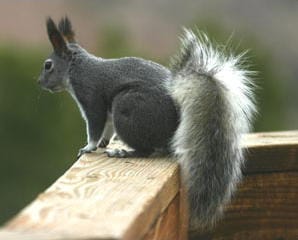 Photo: Hari Viswanathan |  Abert's Squirrel, Tassle-eared Squirrel(Sciurus aberti)Family: Sciuridae (Squirrels, Chipmunks, Marmots, and Prairie Dogs) Size: 18.3 - 23 in (46 - 58 cm) Status: native; locally common Habitat: coniferous forests with yellow or ponderosa pine This squirrel is named after the American naturalist Colonel John James Abert. It’s most distinctive feature is its tuffed ears which it sheds for the summer. Although the Abert’s Squirrel will nest and use food from a few other types of trees, it has a particular affinity for the Ponderosa Pine. Females make spherical nests high up in the trees. In addition these squirrels eat various parts of the Ponderosa Pine from the seeds in the cones to the inner bark, buds and pollen cones. They also eat a particular kind of fungi and spread its spores. This act actually benefits the Ponderosa Pine. The Abert’s squirrel is diurnal and does not store food like other squirrels. Tracks Info Photos Distribution Featured |
 Photo: Phil Armitage |  Least Chipmunk(Tamias minimus, Neotamias minimus)Family: Sciuridae (Squirrels, Chipmunks, Marmots, and Prairie Dogs) Size: 6.6 - 8.9 in (17 - 23 cm) Status: native; common Habitat: pastures, piney woods, rocky cliffs, coniferous forests, brushlands, prefers lower elevations Typical location: Los Alamos Tamias minimus is the smallest and most wide spread chipmunk species in North America. Least Chipmunks are diurnal and eat plant materials (seeds, berries, nuts and fruits) and insects. They often built and use nests in trees during the summer months. However, during the colder months they live in a simple burrow. They spend winter in a state of torpor, waking occasionally to eat food stored in the burrow or from nearby caches. The Least Chipmunk is very agile and communicates with a series of chipping sounds while flicking its tail up-and-down. Tracks Info Photos Distribution |
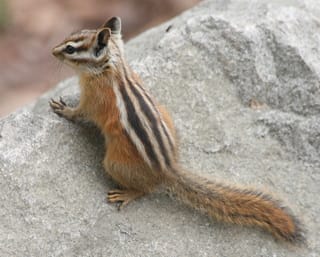 Photo: J. N. Stuart |  Colorado Chipmunk(Tamias quadrivittatus, Neotamias quadrivittatus)Family: Sciuridae (Squirrels, Chipmunks, Marmots, and Prairie Dogs) Size: 8.1 - 9.4 in (21 - 24 cm) Status: native; common Habitat: pine forests, alpine and subalpine habitats, prairies, shrub and brushlands, prefers higher elevations Typical location: Los Alamos The Colorado Chipmunk is larger than the Least Chipmunk and when it vocalizes it sways its tail side-to-side rather than up-and-down like the Least Chipmunk. Colorado Chipmunks are territorial and solitary except during the breeding season. They feed on a variety of plant materials and potentially insects. They will collect food in autumn to cache for winter. Although, these chipmunks do climb trees they are primarily ground dwellers often living in rocky areas in burrows. Tracks Info Photos Distribution |
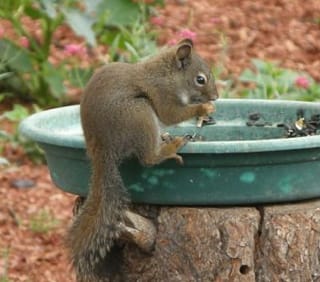 Photo: Yvonne Keller |  Red Squirrel, American Red Squirrel, Pine Squirrel(Tamiasciurus hudsonicus)Family: Sciuridae (Squirrels, Chipmunks, Marmots, and Prairie Dogs) Size: 10.6 - 15.3 in (27 - 39 cm) Status: native; locally common Habitat: forests and wooded mountains, alpine and subalpine habitats, towns The Red Squirrel has curved front claws and powerful hind legs allowing it to climb and jump in the trees. It is smaller than other squirrels and has a distinctive red coat. In summer it can have black stripes on its sides that fade during winter. Red Squirrels are primarily active in the early morning and late afternoon. They are fierce defenders of their territories making a variety of chattering and screeching sounds. They rarely nest in a burrow but rather have one or more nests in the branches of trees. They will eat a variety of plant materials but specialize in seeds from conifer cones giving them one of their common names of Pine Squirrel. In late summer and early fall, the squirrels gather cones and store them in a central cache for use over the winter. A sure sign of squirrel activity is a large pile of fallen seed cone scales called a “midden”. Tracks Info Photos Distribution |
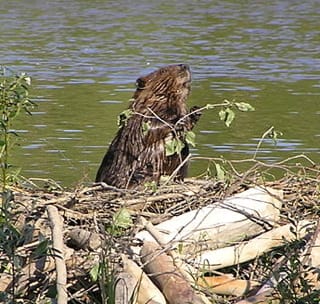 Photo: Marcin Klapczynski 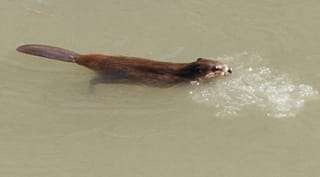 Photo: Stephen Shankland |  American Beaver(Castor canadensis)Family: Castoridae (Beavers) Size: 36 - 48 in (91 - 122 cm) Status: native; common Habitat: marshes, lakes, ponds Typical location: Rio Grande, Upper Jemez River Drainage, White Rock Canyon The American Beaver is the largest rodent in North America. It is active throughout the year and most likely to be observed in the evening. Beavers are particularly adapted to their semi-aquatic life with a paddle-shaped tail, webbed feet and eye coverings that allow them to see underwater. Although beavers eat a variety of vegetation they do not eat fish. Most of their diet is composed of tree bark and the soft tissue that grows under the bark known as cambium. Gnawed trees near water are indicative of beaver activity. Beavers live in small family groups in a lodge built as part of a dam structure. The dam which helps to provide deep enough water around the lodge to keep it from freezing in the winter and floods areas near the edge of the water to provide safer access to food. In addition, the dam creates a new wetland environment for other species. However, it can also cause the lose of habitat for other species by slowing water flow and flooding low-lying areas. Tracks Info Photos Distribution Featured |
 Photo: J.N. Stuart  Photo: Akkana Peck |  Common Muskrat(Ondatra zibethicus, Castor zibethicus)Family: Cricetidae (New World Rats and Mice, Voles, Hamsters, and Relatives) Size: 16.1 - 24 in (41 - 61 cm) Status: native; uncommon Habitat: fresh marshy land along waterways Typical location: Fenton Lake, Rio Grande, Upper Valle Caldera, White Rock Canyon The Common Muskrat is a medium-sized semi-aquatic rodent named for its scent which is particularly strong during the breeding season. The muskrat has a rudder-like tail that is flattened side-to-side, partially webbed feet and a thick coat that traps air for warm and buoyancy. During the 20th century muskrats were heavily trapped for their pelts and were even introduced into Europe as a fur source. Muskrats normally live in groups consisting of a male and female pair and their young. During the summer they usually live in a tunnel dug into the river bank with an entrance located underwater. During the winter, they build lodges constructed of aquatic plants built atop of piles of roots or mud in or along river banks. Muskrats are most active at dusk and dawn and fed primarily on aquatic vegetation but also eat some small aquatic animals. Tracks Info Photos Distribution |
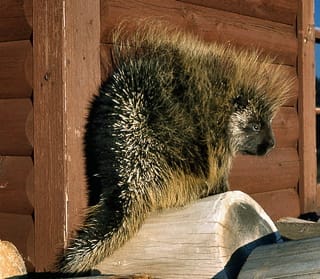 Photo: Mary Meagher, National Park Service 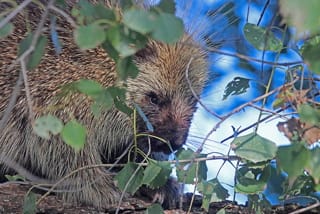 Photo: Jerry Oldenettel |  North American Porcupine, Common Porcupine(Erethizon dorsatum)Family: Erethizontinae (New World Porcupines) Size: 26 - 37 in (66 - 94 cm) Status: native; uncommon Habitat: dry scrubby areas with scattered trees The North American Porcupine is a large, slow-moving rodent which is either black or dark brown with white highlights. Its quills are sharp, modified hairs that are form hollow spines with barbs on the ends. The quills are primarily used for defense but also serve to insulate during winter. Porcupines are able to contract the muscles near the skin causing the quills to stand away from their bodies. In this position, the quills are easily detached and can become lodged into an attacker. The barbs make the quills hard and painful to remove. Porcupines make dens in caves, decaying logs and hollow trees. They do not hibernate but will stay in their dens during bad weather. Porcupines are good climbers and are often seen up in trees foraging for food. In summer they eat a variety of vegetation including twigs, roots, leaves and grasses. In winter they primarily consume conifer needles and the bark, cambium and phloem of trees. Tracks Info Photos Distribution |
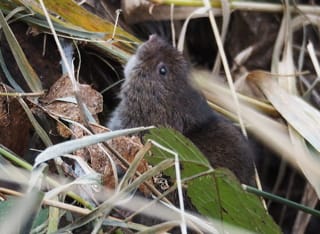 Photo: J. Maughn |  Long-tailed Vole(Microtus longicaudus)Family: Cricetidae (New World Rats and Mice, Voles, Hamsters, and Relatives) Size: 6.1 - 8.8 in (16 - 22 cm) Status: native; uncommon Habitat: dry, grassy areas, mountain slopes These voles like a cool, moist habitat so they are most often found near mountain peaks. Long-tailed Voles have small bodies with long, bicolored tails which are about a third of their total body length. They are active year-round primarily during the day and live in burrows that they dig themselves. They mostly eat fruits and seeds but also eat fungi, bark and leaves. They have numerous predators including owls, hawks and weasels. They typically live no more than a year resulting in population numbers fluctuating widely. Info Photos Distribution |
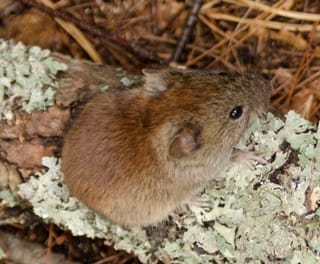 Photo: Phil Meyers |  Southern Red-backed Vole, Gapper's red-backed Vole(Myodes gapperi, Clethrionomys gapperi)Family: Cricetidae (New World Rats and Mice, Voles, Hamsters, and Relatives) Size: 4.8 - 6.3 in (12 - 16 cm) Status: native; uncommon Habitat: cool, damp forests, bogs and swamps These voles have short bodies with a distinctive reddish band that runs along the back and a short tail. They are active year-round and do not hibernate. Southern Red-backed Voles live in burrow systems made by other rodents. In summer they move from their burrows under the protection of natural runways through the undergrowth. During winter they create tunnels in the snow to serve this same purpose. They eat plant materials, fungi, insects and even snails. They also cache some foods for later use — roots, bulbs and nuts. Southern Red-backed Voles are considered to be an ecological indicator of conditions of old-growth forests in the Rocky Mountains. Info Photos Distribution |
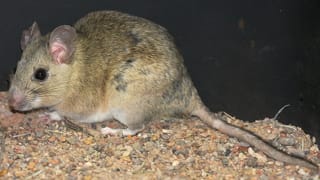 Photo: J. N. Stuart |  White-throated Woodrat(Neotoma albigula)Family: Cricetidae (New World Rats and Mice, Voles, Hamsters, and Relatives) Size: 11.1 - 15.8 in (28 - 40 cm) Status: native; common Habitat: arid areas, brushlands of dry plains and deserts The White-throated Woodrat is one of several species of woodrat that are commonly known as packrats due to their tendency to collect various items including manmade objects. It has a distinctive white throat and underside. In addition, its feet are white. These woodrats eats cholla, yucca, grass and various parts of juniper trees but especially like prickly pear cactus. They will also occasionally eat beetles, ants and some small reptiles. A typical woodrat home is constructed of a variety of sticks and other debris around the base of a tree or shrub. There usually will be several entries and exits with various runways and chambers for food storage and nesting. Despite the fact that a den can be quite large in non-rocky areas, it is occupied by a single woodrat or a mother with young. Tracks Info Photos Distribution Featured |
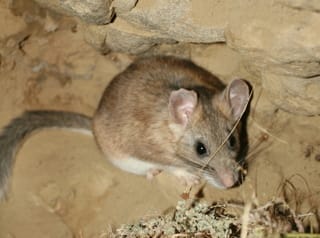 Photo: latraydean |  Bushy-tailed Woodrat, Packrat(Neotoma cinerea)Family: Cricetidae (New World Rats and Mice, Voles, Hamsters, and Relatives) Size: 11.5 - 18.5 in (29 - 47 cm) Status: native; common Habitat: rocky areas, canyons, coniferous forests, alpine and subalpine habitats These woodrats, also known as packrats, have large ears and long, bushy tails. They are good climbers and use their tails for balance while climbing and jumping. Bushy-tailed Woodrats are solitary and highly territorial. Both males and females use a musky substance to mark their territories. They are active throughout the year and are primarily nocturnal. They prefer green vegetation but will eat twigs, fruits, seeds, mushrooms and even insects. These woodrats gather a variety of sticks, leaves, grass, feathers, stones, etc. to build a large shelter around a tree or rock crevice. This den serves to protect them from predators and acts as an eating platform. Within the den there are various tunnels and chambers used for nesting and food storage. Tracks Info Photos Distribution Featured |
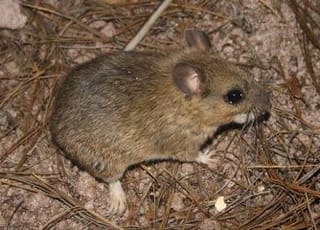 Photo: Juan Cruzado Cortés |  Mexican Woodrat(Neotoma mexicana)Family: Cricetidae (New World Rats and Mice, Voles, Hamsters, and Relatives) Size: 11.4 - 16.6 in (29 - 42 cm) Status: native; common Habitat: rocky outcrops in montane regions, slopes and cliffs, open pine forests The Mexican Woodrat is grayish-brown with white to buff-colored underparts and a gray throat. It is a solitary animal and can be aggressive toward others of its own species. These woodrats forage on the ground but can climb trees. They prefer foliage but will eat a wide variety of seeds, nuts and berries. They will store large amounts of food. They primarily live in rocky areas and therefore tend not to build large shelters like other woodrats. Rather they take advantage of stony cracks and crevices for nest building. Although these dens are not elaborate, they will still have sticks and other debris as well as fecal pellets around them. Tracks Info Photos Distribution Featured |
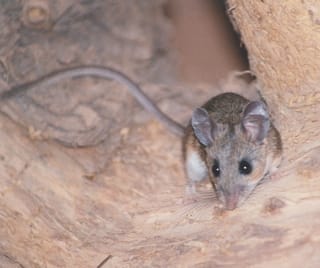 Photo: Juan Cruzado |  Brush Mouse, Brush Deermouse(Peromyscus boylii)Family: Cricetidae (New World Rats and Mice, Voles, Hamsters, and Relatives) Size: 7.1 - 9.4 in (18 - 24 cm) Status: native; common Habitat: arid to semiarid bushy areas The Brush Mouse is very similar to the Pinyon Mouse but has shorter ears and smaller hind feet. Its most distinguishing feature is a long tail with little hair except for a brush-like tuft at the tip. It has keen eyesight and uses chemical cues for communication. These mice are nocturnal and active year-round, although they may enter a state of torpor doing stressful conditions. They are omnivorous, eating various insects, juniper berries and cones and prickly pear cactus. They prefer areas with lots of trees, shrubs and rocks and little grass cover. Their nests are constructed of dry grasses and other vegetation in rock crevices, tree cavities and under logs or boulders. Info Photos Distribution |
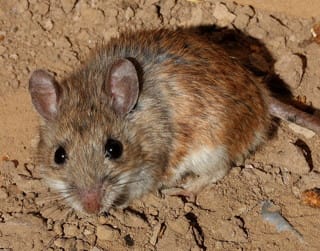 Photo: J.N. Stuart |  White-footed Mouse, Woodmouse(Peromyscus leucopus)Family: Cricetidae (New World Rats and Mice, Voles, Hamsters, and Relatives) Size: 3.5 - 3.9 in (9 - 10 cm) Status: native; uncommon Habitat: warm, dry forests and brushlands White-footed Mice are pale to dark reddish brown with a white belly and feet. They can be hard to distinguish from the North American Deermouse. However, the latter has a longer tail that is distinctly more bicolored. White-footed mice are omnivorous with a diet that includes seeds, berries, nuts, insects, grains, fruits and fungi. Since they do not hibernate, they store seeds and nuts for the winter. They are primarily active at night and are very furtive. White-footed mice build nests in warm, dry places such as a hollow tree or vacated bird's nest. Also though they generally avoid humans, they will sometimes build nests in the walls of buildings. One distinctive behavior of the White-footed Mouse is its tendency to drum on a dry leaf with its fore paws making a long buzzing sound. The meaning of this is not known. Like other deermice they can be carries of various diseases. Info Photos Distribution |
 Photo: J.N. Stuart |  North American Deermouse, Deermouse(Peromyscus maniculatus)Family: Cricetidae (New World Rats and Mice, Voles, Hamsters, and Relatives) Size: 4.6 - 8.8 in (12 - 22 cm) Status: native; common Habitat: brushy areas, woodlands North American Deermice are gray to reddish-brown with white underparts and feet. Their tails have a dark top which is sharply demarcated from a lighter colored underside. One way to distinguish the North American Deermouse from the White-footed Mouse is by the fact that the color separation in tail from top to bottom is much less pronounced for the White-footed Mouse. These deermice will feed primarily on nuts, berries and insects. Like other deermice they are nocturnal and do not hibernate. They construct nests with materials such as grasses, roots, mosses and other fibers near the ground in stumps, logs, tree cavities and even buildings. Like other deermouse species, Peromyscus maniculatus is a carrier for several disease affecting humans including hantavirus and Lyme disease. Info Photos Distribution |
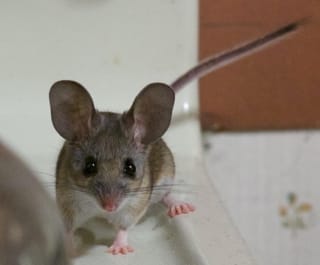 Photo: Mitch Chapman |  Pinyon Mouse, Pinyon Deermouse(Peromyscus truei)Family: Cricetidae (New World Rats and Mice, Voles, Hamsters, and Relatives) Size: 6.8 - 9.1 in (17 - 23 cm) Status: native; common Habitat: open conifer forests, bushy areas and hillsides The Pinyon Mouse's fur color varies by region from yellowish brown to brownish black. Thus it can better blend into the vegetation and hide from predators. It is easily confused with the Brush Mouse as the Pinyon Mouse’s tail is tipped with long hairs. However, it has bigger ears and hind feet than the Brush Mouse. These mice are omnivores, eating insects, worms and fungi but the largest part of their diet is made up of vegetation. In particular, conifer seeds, cones and berries. Pinyon Mice make dens under rock ledges, outcrops, slabs and in trees. They often use multiple dens throughout the day. They do not hibernate but during severe conditions they can enter a state of torpor to save energy. Pinyon Mice are known to harbor the ticks that transmit Rocky Mountain Spotted Fever and Lyme disease. Info Photos Distribution |
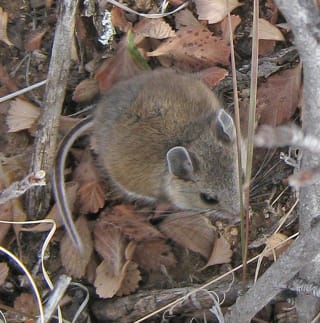 Photo: Jennifer Macke |  Western Harvest Mouse(Reithrodontomys megalotis)Family: Cricetidae (New World Rats and Mice, Voles, Hamsters, and Relatives) Size: 4.5 - 6.8 in (11 - 17 cm) Status: native; common Habitat: dry grassy areas, deserts, pine-oak forests The Western Harvest Mouse is not territorial and often congregates near others of its species. It uses a nest as a base for its activity. The nest is situated under some protective cover and is woven from grasses and other plant materials. It will also use runways and burrows of other rodents. Western Harvest Mice eat seeds and other vegetation as well as certain insects such as grasshoppers and caterpillars. They cache food in their nests. These mice are strictly nocturnal and are active throughout the year. However, they can enter a state of torpor when the temperature is very cold. Like other mice they are a vector for hantavirus. Info Photos Distribution |
 Photo: Mitch Chapman |  Botta's Pocket Gopher(Thomomys bottae)Family: Geomyidae (Gophers) Size: 6.6 - 10.8 in (17 - 27 cm) Status: native; common Habitat: can be found nearly anywhere except desert or rocky terrain Botta’s Pocket Gopher is the most common gopher in Los Alamos County. Its coloration is highly variable and it like all pocket gophers is notable for having deep cheek pouches. It is very hard to tell The Botta's Pocket Gopher from the Northern Pocket Gopher by sight but former tends to occur at lower elevations. These pocket gophers are strict vegetarians eating roots, bulbs, tubers and occasionally other plant parts. They are solitary and territorial. They do not hibernate and are active throughout the year. However, they spend most of their time underground. They use their claws and front teeth to dig their own extensive burrow systems. Their burrows contain specialized chambers for nesting, food storage and defecation. They do not leave raised ridges above ground near tunnel entrances but rather throw up mounds of soil near their openings. Though often considered pests, their burrowing and burying of vegetation helps to enrich and aerate the soil. Info Photos Distribution |
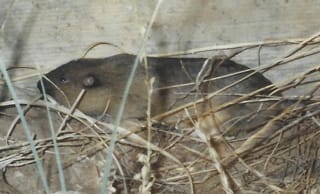 Photo: Kenneth Bader |  Northern Pocket Gopher(Thomomys talpoides)Family: Geomyidae (Gophers) Size: 6.5 - 9.1 in (17 - 23 cm) Status: native; uncommon Habitat: along streams with good soil, most often in mountains The Northern Pocket Gopher has the greatest range of any pocket gopher in North America. It is very similar to Botta’s Pocket Gopher only differing physically in skull structure and dentition. However, the Northern Pocket Gopher tends to live at higher elevations. These pocket gophers can vary in color from gray to shades of brown. Their color usually approximates the color of the local soil. They tend to avoid areas with open canopy and sparse ground cover. Like all pocket gophers, they are good diggers, using both feet and teeth to make an extensive burrow system with specialized chambers. They rarely appear above ground and when they do they usually do not go more that a few feet (less than a meter) from a burrow entrance. Northern Pocket Gophers are very territorial and do not hibernate. They primarily consume plant roots, bulbs and stems. They particularly like the fruit of the prickly pear and tend to avoid woody vegetation. Info Photos Distribution |
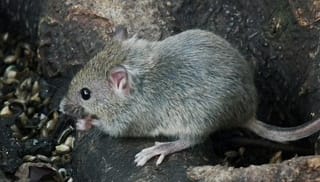 Photo: Junge Hausmaus |  House Mouse(Mus musculus)Family: Muridae (Old World Rats and Mice) Size: 5.1 - 7.8 in (13 - 20 cm) Status: introduced; uncommon Habitat: areas with good ground cover, cultivated fields, buildings The House Mouse is an introduced species that spread throughout North America following European colonization. They are most often found in buildings but can spread to nearby open fields. They have been domesticated and kept both as pets and used for biological research. In the wild they vary in color from shades of brown to gray. Their ears and tails have little hair and they make a high-pitched squeaking sound. They can be confused with the Harvest Mouse but the latter has more of a reddish back and lighter underside. Mice that live in close proximity to humans display commensal behavior; i.e., they live in small groups with a hierarchy of individuals. In the wild, these mice are territorial and short-lived, usually no more than one year. House Mice are not usually vectors for human diseases. Info Photos Distribution |
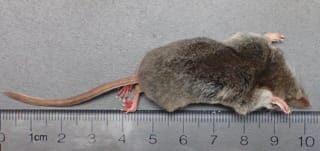 Photo: Matt Bowser |  Dusky Shrew, Montane Shrew(Sorex monticolus)Family: Soricidae (Shrews) Size: 3.8 - 5.5 in (10 - 14 cm) Status: native; uncommon Habitat: thick grassy areas near streams, alpine and subalpine areas The Dusky Shrew is a small, long tailed shrew with brown or grey fur. It is found across a large portion of western North America. Dusky Shrews are solitary and do not hibernate. They can be seen at any time of the day but tend to be most active during the early morning or at several periods during the night. Due to their small size they lose heat quickly and therefore must consume large quantities of prey. They eat insects and their larvae, earthworms, spiders, snails and other small invertebrates. They spend most of their time hunting and feeding. Info Photos Distribution |
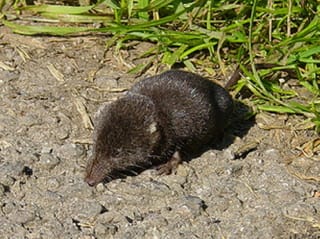 Photo: Nick Jones |  American Water Shrew, Northern Water Shrew(Sorex palustris)Family: Soricidae (Shrews) Size: 5.6 - 6.3 in (14 - 16 cm) Status: native; uncommon Habitat: among boulders along mountain streams, alpine and subalpine areas The American Water Shrew has a slender body, a long tail and a snout that is constantly moving. These shrews swim and dive down to stream bottoms looking for food and trying to escape predators. They need to keep paddling furiously so as to not bob to the surface. Their fur traps air making them buoyant. Shrews cannot go without food for more than a few hours. So they are often on the hunt throughout the day and night. They prefer the larvae and nymphs of aquatic insects like caddisflies and stoneflies but will occasionally eat small fish and some vegetation. On land, they will catch flies, worms and snails. They are aggressive and solitary creatures living in nest built under hollow logs or in tunnels. Info Photos Distribution |
